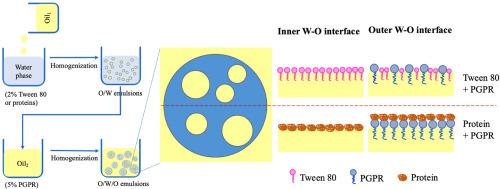Dual stabilization of O/W/O double emulsions by proteins: An interfacial perspective
Abstract
Oil-in-water-in-oil (O/W/O) double emulsions are regarded as a promising emulsion system to accomplish multifunctionality in the food industry. However, the stability of the complex structure of O/W/O double emulsions is still a problem to be solved due to the presence of two completely opposite water-oil interfaces. To overcome this issue, the application of proteins was investigated to demonstrate their stabilization effect on the O/W/O double emulsion. In this study, a model O/W/O double emulsion was formulated with the commercial emulsifiers Tween 80 and polyglycerol polyricinoleate (PGPR), and then different proteins were introduced to alternate Tween 80. The results showed that the release rate of the inner oil to the outer phase in O/W/O double emulsions stabilized by proteins and PGPR was significantly reduced by about 30% after 2 weeks of storage compared to Tween 80. The stabilization mechanism was verified using drop shape tensiometry, and it was found that whey protein isolate (WPI) and modified pea protein isolate (MPPI) could improve the interfacial moduli of both the inner and outer W–O films, further strengthening the mechanical properties of W–O interfaces against deformation and hence achieving the dual stabilization of O/W/O double emulsions. On the other hand, sodium caseinate (SC) only enhanced the interfacial properties of the PGPR-covered external interface compared to Tween 80. Taken together, this work provides a better understanding of how the composition of the intermediate water phase affects the stability of O/W/O double emulsions and paves the way to design highly stable O/W/O emulsions for food application.


 求助内容:
求助内容: 应助结果提醒方式:
应助结果提醒方式:


